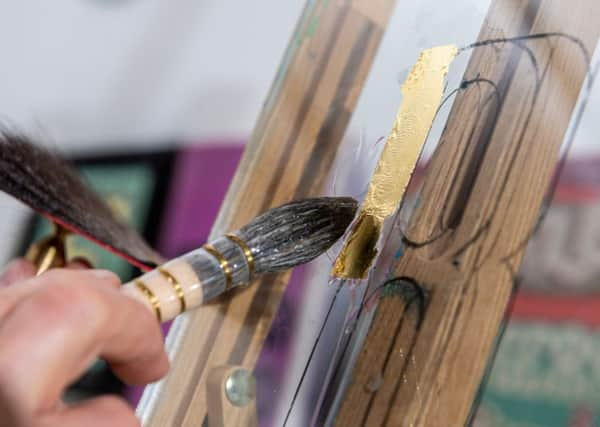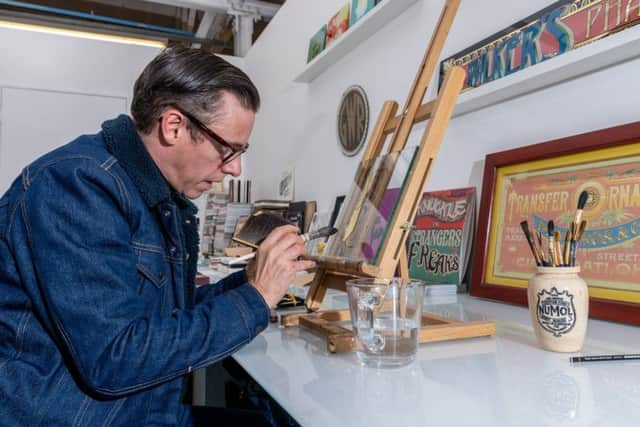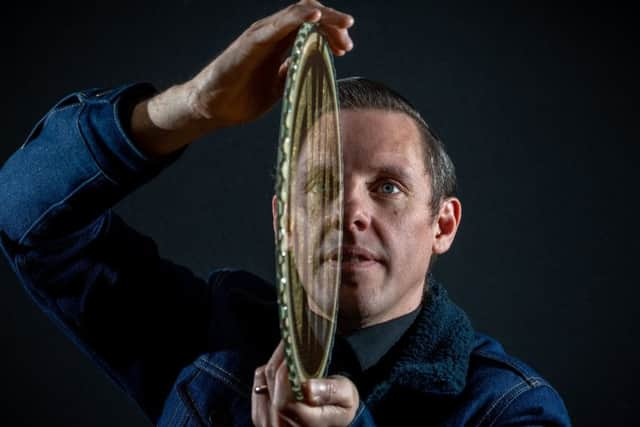Signs for our times - the Huddersfield glass signmaking craftsman


The famous textile mills are woven into the fabric of Huddersfield’s history – its reputation and prosperity were founded on its textile industry.
So much so that at its zenith the name ‘Made in Huddersfield, England’ became a highly revered global brand.
Advertisement
Hide AdAdvertisement
Hide AdIt’s perhaps fitting, then, that one of the mills that helped put the West Yorkshire town on the map more than a century ago continues to be a hub of creativity and craftsmanship. In Robert Walker’s case, though, the material involved is glass and paint, rather than wool.


From his studio, part of the impressive Bates Mill complex, Robert runs his own business – Signs by Umberto – which specialises in traditional signwriting and reverse glass sign making.
The name, as he explains, has a family connection. “Umberto was a name my father gave to me at a young age. He has a nickname for each of his four sons that all come from films or TV programmes.”
So when he set up his signwriting business it was a little nod to his father. “My dad still calls me ‘Umberto’, as does my mum, so it felt like the right choice to call my business Signs by Umberto,” he says.
Advertisement
Hide AdAdvertisement
Hide AdThough Robert’s one-man business has only been going for a couple of years, his passion for signwriting is etched far deeper.


He grew up in Shelf, near Halifax, and as a teenager did his school work experience with a signwriter called Brian Scargill in Bradford, helping him work on murals at the Eureka Museum. “I saw his van driving through my village and I noticed that aspects of the lettering on the side of the van had real gold leaf and I was blown away by the craftsmanship and artistic nature of it, because I hadn’t seen anything like it before. But I didn’t realise that I’d fall in love with the construction of letter forms and the drawing of letter forms.”
He then spent time working as a signwriter for a Saturday job which fuelled his interest further, though subsequently his career swerved towards art and graphic design before he became a lecturer.
Robert has been working in the field of signwriting for more than 15 years, but it was when he accidentally stumbled upon the work of David A Smith – a designer, gilder and glass embosser based in Devon – while doing online video research for a lecture, that the seeds of his future business were sown. “I was trying to find something to inspire my students and I came across this clip of Smith in his studio where he was working on the album cover for Born and Raised. He’d been commissioned by Sony to create a reverse glass-gilded sign for John Mayer along with this fantastic album cover and the film brought me to tears to be honest, it was just absolutely wonderful.”
Advertisement
Hide AdAdvertisement
Hide AdIt showed Smith working on intricate signage that Walker found mesmerising. “What he was doing was based around heritage and craft and it was all underpinned by signwriting. It really resonated with me because I’d trained with a signwriter and all of a sudden watching him I thought ‘I want to be part of this.’”
By this time he felt he needed a fresh challenge that moved away from modern technology. “I felt I was losing my soul to the digital world a little bit and I wanted to return to that core skill and craft.”
A couple of years later he quit lecturing and set up Signs by Umberto. “I’d been a painter for many years and shown my work internationally so I’ve always worked with my hands.”
He became fascinated by a form of sign making known as Verre Églomisé, a French term referring to process of gilding on the reverse side of glass creating a soft mirrored effect.
Advertisement
Hide AdAdvertisement
Hide AdThis became popular during the late 19th century when Victorian gilders turned it into an art form. “When you see gold going on to glass and you see it drying, there’s something magical about that. When you then refine this and build it into lettering the whole thing starts to sing.”
However, by the early 1990s such skills began to appear obsolete with the emergence of new digital technology. “The plotter cutter and the vinyl generation of sign making started to come about which made signwriters almost extinct within a few years,” says Robert. “When you can lay something about by hand and add your own warmth and style to it then you’re doing something that a plotter cutter can’t replicate.”
More recently, though, there’s been something of a renaissance in artisan crafts, and the skills that underpin them.
“I think people want to see something that’s handcrafted and there’s an appreciation for the skill that’s involved.
Advertisement
Hide AdAdvertisement
Hide Ad“There’s a big resurgence now in signwriters young and old who are wanting to learn those techniques again.”
Working with paint and glass is a painstaking process. “It’s very detailed, even down to the fluidity of the paint because you need to add chemicals to the paint to get that right. I’m often using gold and if I get that wrong then it can be an expensive mistake – it’s only through experience and trial and error that this becomes second nature,” he says.
“I’ve just finished a piece that took around 115 hours because sometimes things happen with the materials that you don’t expect, so it can be tricky – the material dictates how you should work. But that’s what I love about it, you can’t rush it and when you do it well the rewards are enormous.”
These techniques aren’t confined to glass – he recently gilded a memorial cast iron pit wheel in Doncaster. “There used to be a big pit at Cadeby Main, which is now a housing complex, and in memory of those who lost their lives in some of the disasters there in the past they installed a big pit wheel and I was asked to do the lettering which I gilded in real gold leaf.”
Advertisement
Hide AdAdvertisement
Hide AdMost of Robert’s work comes from private commissions. “There are only around 30 people in the country that I know of practising this. I think I’m the only one doing reverse glass gilding in Yorkshire. So we are few and far between.”
“I love the tactile nature of working with these materials. Seeing the gold jump off your guilder’s brush onto the glass and then watching it dry and turn into a mirror is something I never tire of.
“When the gold finally goes on that needs two coats and has to be burnished properly so you don’t get streaks. It’s like alchemy... or baking a really good cake.”
www.signsbyumberto.co.uk